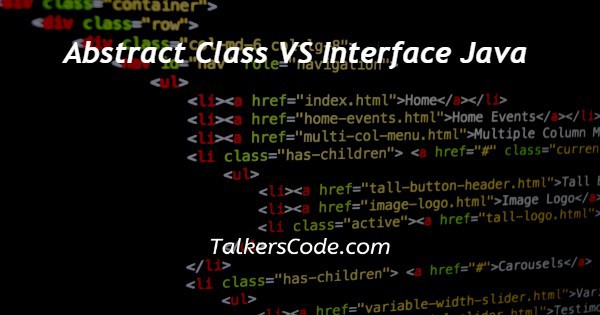Abstract Class VS Interface Java
Last Updated : Mar 11, 2024
IN - Java | Written & Updated By - Ashish

In this article we will show you the solution of abstract class vs interface java, Creating abstract classes and interfaces is a way to define abstract methods by creating abstractions.
An abstraction of a feature refers to hiding the internal implementation from users and only presenting the functionality.
The workings of those systems are shown, but their workings are hidden.
Since abstract classes and interfaces are both used in the abstraction process, it is necessary to have both.
The only type of method that can be added to an interface is an abstract method.
Abstraction can be used in abstract classes as well as non-abstractions. There are also default and static methods available from Java 8. Private concrete methods are also supported from Java 9.
In Java, variable declarations in interfaces are considered final. It is possible for abstract classes to contain variables that are not final.
Implementing a Java interface using the keyword "implements" and extending an abstract class using the keyword "extends" are two ways to store the interface in Java code.
Private, protected, and other class members can be found in Java abstract classes.
Interfaces are implemented by classes, while Abstract Classes are inherited by classes.
There are no access modifiers in Interface. A public modifier is assumed for everything defined inside an Interface, whereas an access modifier can be applied to an Abstract Class.
Data fields cannot be contained in an Interface, but they can be contained in an abstract class.
Classes' peripheral capabilities are defined by interfaces, whereas classes' identities are defined by abstract classes.
Those classes whose declarations contain the abstract keyword are called abstract classes.
Each abstract class should have no more than one abstract method. Methods without a body, that is, methods that do not have a body.
There can be multiple implementations of a concrete method.
You can use abstract classes to create blueprints for concrete classes.
The inheriting class, on the other hand, must implement the abstract method.
A blueprint, an interface, can be used to implement a class. The interface contains no concrete methods.
A static final variable (such as a constant class variable) can appear in an interface, but it is never an instance variable.
Step By Step Guide On Abstract Class Vs Interface Java :-
abstract class demo {
abstract void printInfo();
}
class employee extends demo {
void printInfo() {
String name = "amruta";
int age = 23;
float salary = 200000;
System.out.println(name);
System.out.println(age);
System.out.println(salary);
}
}
class base {
public static void main(String args[]) {
demo s = new employee();
s.printInfo();
}
}
- Creating the abstract class as a demo is the first step.
- Next, we declare an extends class that also extends demo.
- Next, we print employee information such as name, age, and salary.
- Once the base class has been created, we define a public static void main method.
- In the following step, we declare a new employee method
Conclusion :-
An abstraction of a feature refers to hiding the internal implementation from users and only presenting the functionality.
The workings of those systems are shown, but their workings are hidden.
Since abstract classes and interfaces are both used in the abstraction process, it is necessary to have both.
I hope this article on abstract class vs interface java helps you and the steps and method mentioned above are easy to follow and implement.













